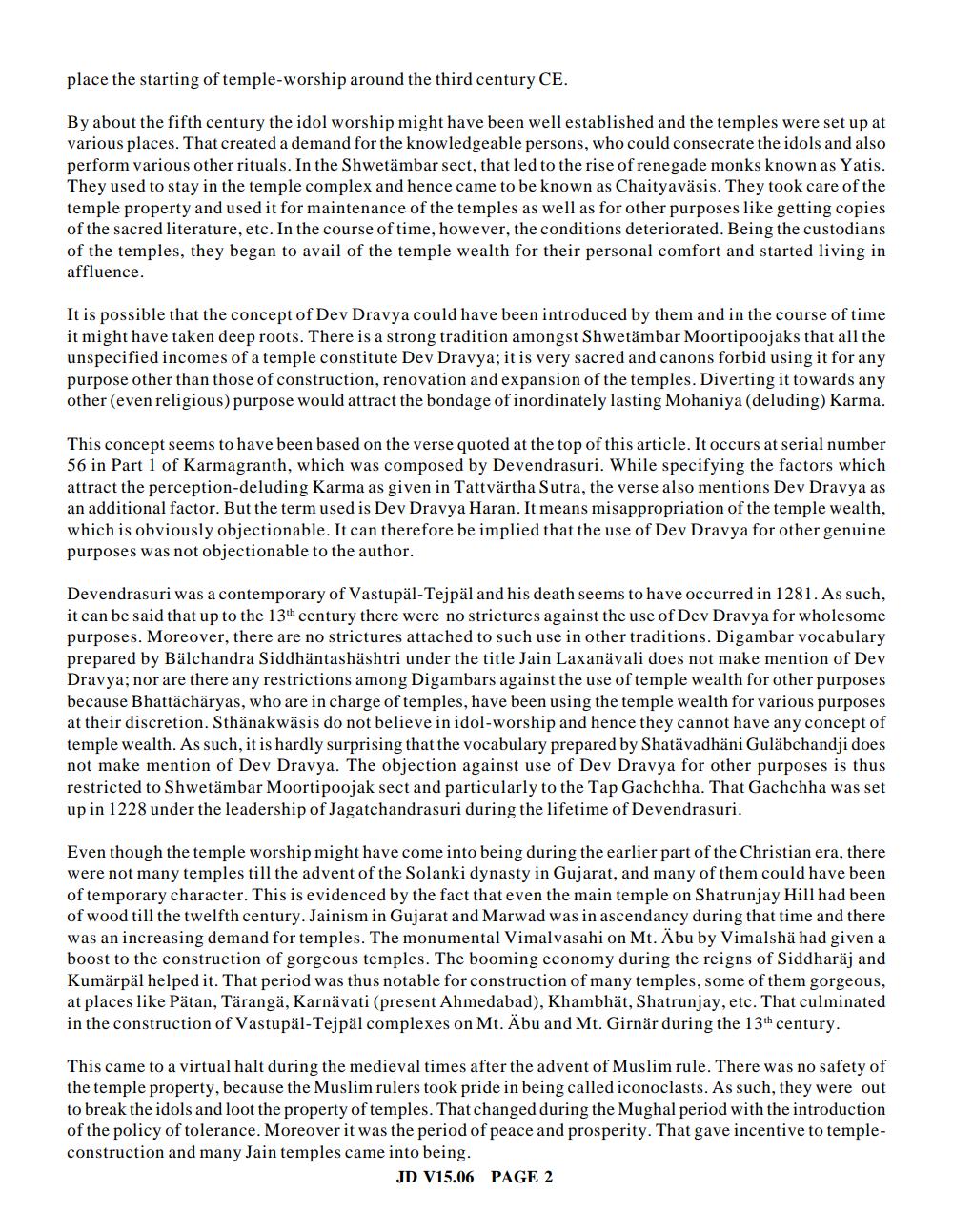Book Title: Dev Dravya Author(s): Manu Doshi Publisher: Manu Doshi View full book textPage 2
________________ place the starting of temple-worship around the third century CE. By about the fifth century the idol worship might have been well established and the temples were set up at various places. That created a demand for the knowledgeable persons, who could consecrate the idols and also perform various other rituals. In the Shwetämbar sect, that led to the rise of renegade monks known as Yatis. They used to stay in the temple complex and hence came to be known as Chaityaväsis. They took care of the temple property and used it for maintenance of the temples as well as for other purposes like getting copies of the sacred literature, etc. In the course of time, however, the conditions deteriorated. Being the custodians of the temples, they began to avail of the temple wealth for their personal comfort and started living in affluence. It is possible that the concept of Dev Dravya could have been introduced by them and in the course of time it might have taken deep roots. There is a strong tradition amongst Shwetambar Moortipoojaks that all the unspecified incomes of a temple constitute Dev Dravya; it is very sacred and canons forbid using it for any purpose other than those of construction, renovation and expansion of the temples. Diverting it towards any other (even religious) purpose would attract the bondage of inordinately lasting Mohaniya (deluding) Karma. This concept seems to have been based on the verse quoted at the top of this article. It occurs at serial number 56 in Part 1 of Karmagranth, which was composed by Devendrasuri. While specifying the factors which attract the perception-deluding Karma as given in Tattvärtha Sutra, the verse also mentions Dev Dravya as an additional factor. But the term used is Dev Dravya Haran. It means misappropriation of the temple wealth, which is obviously objectionable. It can therefore be implied that the use of Dev Dravya for other genuine purposes was not objectionable to the author. Devendrasuri was a contemporary of Vastupäl-Tejpal and his death seems to have occurred in 1281. As such, it can be said that up to the 13th century there were no strictures against the use of Dev Dravya for wholesome purposes. Moreover, there are no strictures attached to such use in other traditions. Digambar vocabulary prepared by Bälchandra Siddhantashäshtri under the title Jain Laxanävali does not make mention of Dev Dravya; nor are there any restrictions among Digambars against the use of temple wealth for other purposes because Bhattachäryas, who are in charge of temples, have been using the temple wealth for various purposes at their discretion. Sthänakwäsis do not believe in idol-worship and hence they cannot have any concept of temple wealth. As such, it is hardly surprising that the vocabulary prepared by Shatavadhäni Guläbchandji does not make mention of Dev Dravya. The objection against use of Dev Dravya for other purposes is thus restricted to Shwetämbar Moorti poojak sect and particularly to the Tap Gachchha. That Gachchha was set up in 1228 under the leadership of Jagatchandrasuri during the lifetime of Devendrasuri. Even though the temple worship might have come into being during the earlier part of the Christian era, there were not many temples till the advent of the Solanki dynasty in Gujarat, and many of them could have been of temporary character. This is evidenced by the fact that even the main temple on Shatrunjay Hill had been of wood till the twelfth century. Jainism in Gujarat and Marwad was in ascendancy during that time and there was an increasing demand for temples. The monumental Vimalvasahi on Mt. Äbu by Vimalshä had given a boost to the construction of gorgeous temples. The booming economy during the reigns of Siddharäj and Kumärpäl helped it. That period was thus notable for construction of many temples, some of them gorgeous, at places like Pätan, Täranga, Karnävati (present Ahmedabad), Khambhät, Shatrunjay, etc. That culminated in the construction of Vastupäl-Tejpal complexes on Mt. Äbu and Mt. Girnär during the 13th century. This came to a virtual halt during the medieval times after the advent of Muslim rule. There was no safety of the temple property, because the Muslim rulers took pride in being called iconoclasts. As such, they were out to break the idols and loot the property of temples. That changed during the Mughal period with the introduction of the policy of tolerance. Moreover it was the period of peace and prosperity. That gave incentive to templeconstruction and many Jain temples came into being. JD V15.06 PAGE 2Page Navigation
1 2 3 4 5 6 7 8
